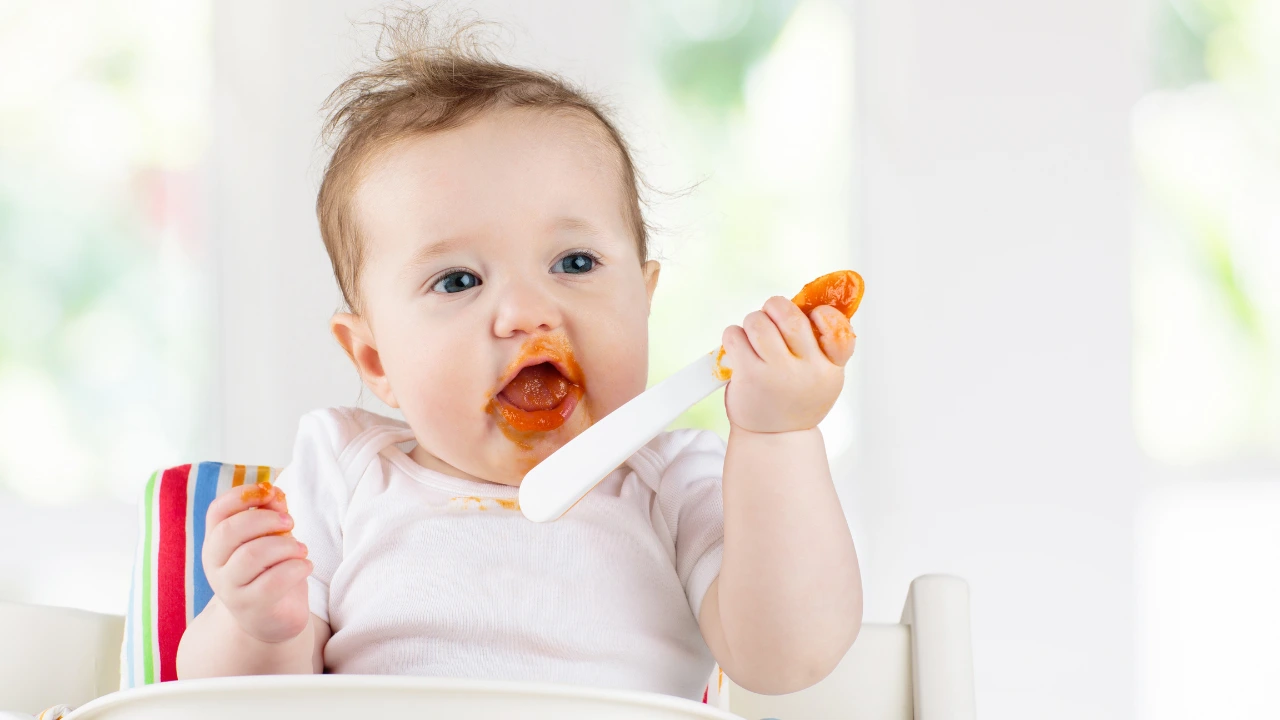
Baby cereal is made with oats, barley, rice, or other grains that are ground finely. Fortified baby cereal has added iron and other vitamins and nutrients, making it a good first food for your baby. It has a number of minerals, including iron, zinc, and magnesium; and some varieties have vitamins (such as vitamins A, E, D, and B), too.
To prepare baby cereal, you can add 1 tablespoon of breast milk, formula, or water to 4 or 5 tablespoons of cereal to give it a soupy consistency; add less fluid as your baby gets the hang of eating more textured food. You can also mix baby cereal with other baby food to introduce your little one to a variety of textures and tastes.
When do babies start eating cereal?
As soon as your baby is ready to eat solid foods, they can try baby cereal. Babies are usually ready to start solids around 6 months. Signs that they’re ready include having good head and neck control, being able to sit up on their own, and showing an interest in food (opening their mouth and leaning forward when it’s near).
You can also mix baby cereal with other purees, like pear, squash, or prunes, to help them get used to varieties of food. This could be helpful if your baby likes the taste of cereal, but seems reluctant to try other foods. If the puree seems too thick for them, add more liquid to thin it out and make it easier to swallow.
Always feed your baby cereal with a spoon – don’t add it to formula or breast milk in a bottle, since your baby could choke on it and they may end up eating more than they need.
Is baby cereal safe?
Baby cereal is safe as long as it’s prepared correctly and your baby is ready for solid foods. In fact, baby cereal can be an important part of your baby’s diet, since many varieties are fortified with essential nutrients.
Fortified baby cereal is an excellent source of iron, which babies need starting at around 6 months. This is especially important if your baby is breastfed, since breast milk doesn’t contain very much iron. (Many formula varieties are fortified with iron.)
Any time you give your baby a new food, wait three to five days before adding another new food to their diet. That goes for different types of grains, too – if you start by giving your baby oat-based cereal, wait before giving your baby another type of grain, like wheat. This way, if your baby has an allergic reaction, it’ll be easier to pinpoint what might have caused it.
Signs of a food allergy include hives, itchy skin rashes, swelling, nausea, vomiting, diarrhea, wheezing/trouble breathing and pale skin. If you notice any of these symptoms after your baby eats, let their doctor know.
If your baby has symptoms that involve multiple parts of the body (such as hives with vomiting or diarrhea), it could be an anaphylactic reaction. Other signs of an anaphylactic reaction are throat tightness, breathing problems, wheezing, lightheadedness, and loss of consciousness. If your baby shows signs of an anaphylactic reaction, call emergency number or go to an emergency room immediately.
Is rice cereal bad for babies?
Rice cereal isn’t necessarily bad for babies, but it can contain higher levels of arsenic, which can be dangerous if your baby eats too much. Too much rice cereal can also cause constipation.
Arsenic is a common metal that has two forms – organic and inorganic – and many foods and beverages contain both forms in varying levels (including fruit juice). Arsenic is naturally present in water, soil, and air, but processes such as mining, manufacturing, and pesticide use have increased the level of inorganic arsenic in the environment.
Inorganic arsenic is more toxic than organic arsenic and in rare cases can cause certain cancers. (The U.S. Food and Drug Administration estimates that arsenic in rice causes four cases of lung and bladder cancer over a lifetime for every 100,000 people in the U.S.)
Early exposure to arsenic (in the womb, or at a very young age) may also be associated with impaired intellectual development.
Rice is the top dietary source of inorganic arsenic, both because it’s a staple in people’s diets all around the globe and because rice plants tend to absorb more arsenic than other plants.
Babies typically eat much more rice in relation to their weight than adults do, since rice cereal is often a big part of babies’ diets when they first start eating solid foods.
While research shows that most rice cereal brands contain less arsenic than the federally recommended maximum, experts still say it’s best to avoid relying on rice cereal as a main source of iron and other nutrients. Instead, give your baby cereal made from different kinds of grains, like oat, barley, whole wheat, and multigrain, since those contain less arsenic. If you do give your baby rice cereal, make sure it’s part of a varied diet.


Add a Comment